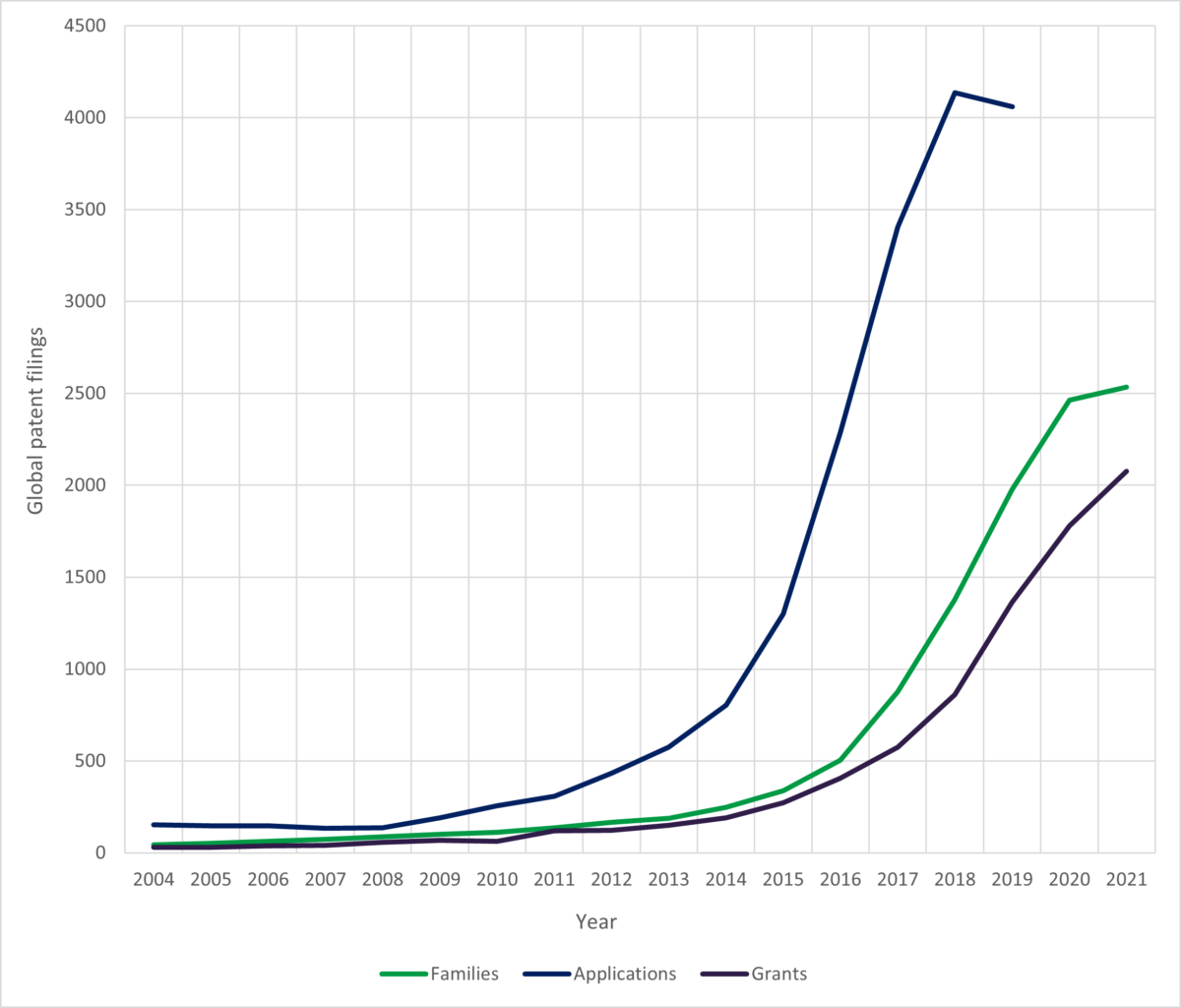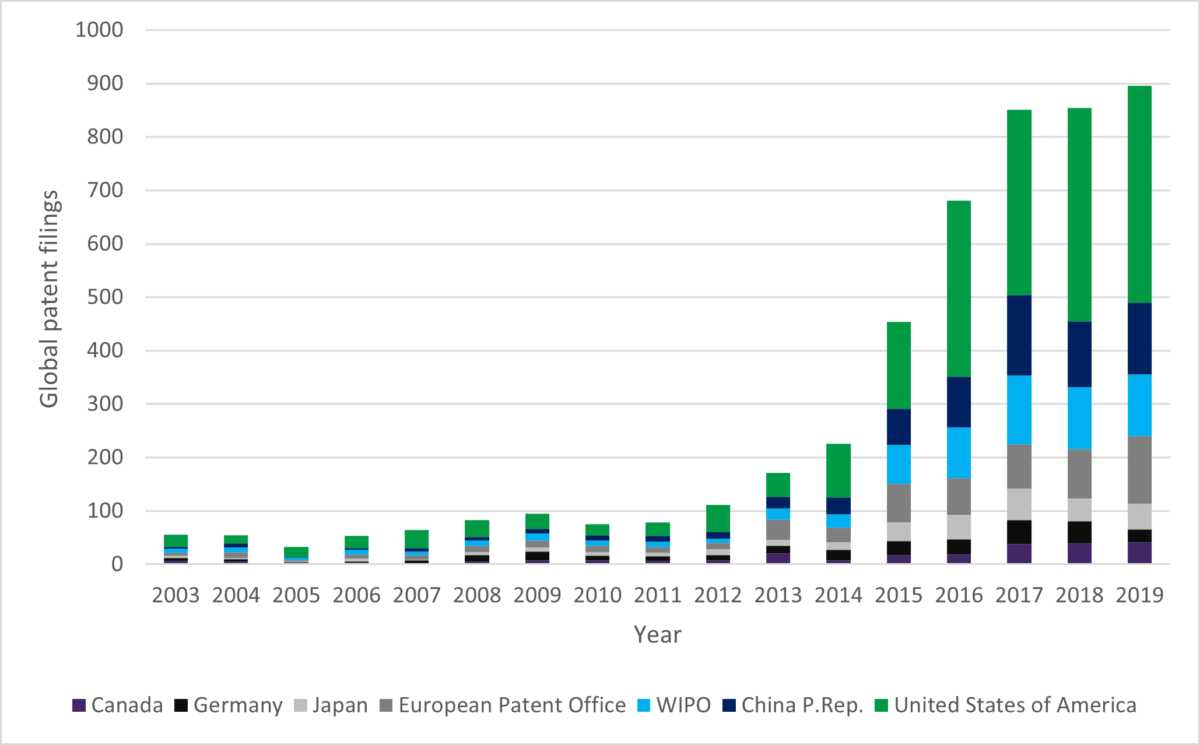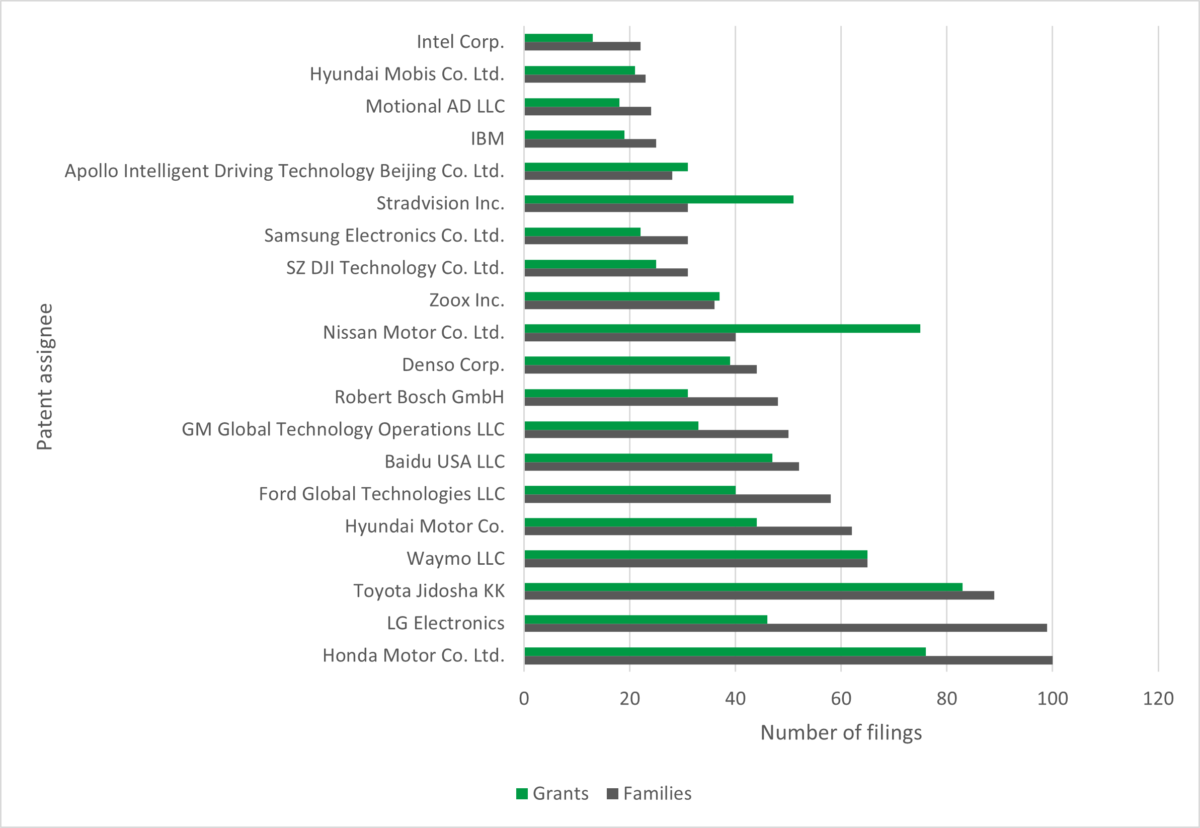About the authors
Richard Bray is a partner and patent attorney. Richard works with a range of clients in technological sectors such as electronic consumer goods, defence, food products, and the more emerging technologies of autonomous vehicles, vehicular head-up displays, virtual and augmented reality, image guided therapy, nuclear (e.g. fusion), quantum security, and more.
Paul Roscoe is a senior associate and patent attorney. Paul has experience of subject-matter including engineering, electronics, and computer-implemented inventions, and in particular, artificial intelligence applications.
Tom Gregory is a trainee patent attorney. Tom’s work is primarily focused on the mechanics and electronics sectors. He also has valuable experience in computer-implemented inventions and software. Tom currently assists clients working in the fields of autonomous vehicles, defence and aerospace.
Our key findings
- Artificial intelligence (AI) patents in autonomous vehicle (AV) technology have been increasing in recent years, but filing numbers fell for the first time in 2019.
- Around 2500 new patent families were published in 2021, compared with around 500 in 2016.
- The top 20 list of assignees include a number of well-established names in the automotive industry, including Honda, Toyota and Ford.
- Tech giants such as LG, Waymo and Samsung are also counted in the top 20 assignees, and it will be interesting to see how these companies exercise their patent rights in the years to come, with the potential for extensive licensing of their patented technology.
Introduction
Artificial intelligence (AI), and machine learning, has gained much media attention of late. Various commentators have raised questions such as whether it is a fad, whether it can be trusted, and whether it will ultimately take over.
For us, as patent attorneys, we like to look at what the patent data can tell us. This field in particular is interesting because some well-established automotive manufacturers hesitate from investing and innovating in new fields, whilst, on the other hand, tech start-ups often prefer to keep their inventions (typically software) a secret and provide their product as a “black-box”. Despite these obstacles, AI patent filings are indeed increasing as the data below shows.
Exemplary specific innovations in this area
The data used to compile the charts in this article include a wide range of innovations. Some patent applications relate to “context aware decision making in autonomous vehicles”. Other patent documents relate to “methods of hailing an autonomous vehicle, using a user interface”.
Indeed, based on our experiences in assisting clients with identifying their intellectual property, many of the patents relate to inventions that inventors (incorrectly!) believe will not be patentable subject-matter (e.g., algorithms), or “inventive” enough to meet the criteria for granted patent protection. As we can see from the data below this is entirely untrue, and there is a great deal of potential value that patent protection can add to this space.
Trends
Fig.1 below shows the patent data trend in the AI and automotive space from 2004 to 2021. As can be seen from fig.1, there has been a significant ramp-up in patent publications starting around 2013. This trend is consistent with other charts we have produced for other application fields where an AI innovation is involved.
The trends for core AI innovations are more exponential. Here the trends, especially the family and grant data, does increase but is more linear. As will be discussed in further detail below, a number of the major patent filers are well-established automotive OEMs. These companies may be innovating with automotive regulation in-mind, and so their filings may be more focused on specific areas, and so the filing numbers have not accelerated as rapidly as core AI innovations. Furthermore, many of the key players are innovating in the electric/hybrid vehicle space – their IP focus (and budget) may be aimed at protecting that technology.
(Fig.1) Patent data trends in the AI and automotive space – 2004-2021

Patent applications, families, and granted patent numbers are included in fig. 1, for the respective year of publication. Fig. 1 is not cumulative.
Most patent offices consider AI innovations applied to AVs to be patentable because they have clear links to the real world through sensor data or control of an AV. This is likely to have encouraged applicants to file applications in this sector.
The grant data is largely maintaining pace with the families data. This demonstrates that patent offices do consider AI innovations in this application field to be patentable. This is a great anecdote for any misconceptions around whether or not it is possible to protect AI innovations, as at their core, they are merely algorithms. Here, it is clear, that AI innovations are being granted, at least in this application field.
It is positive to see that the grant data also shows that patent examiners are keeping on top of the increase in filing numbers. Therefore, it may still be possible to expedite prosecution through the usual channels, e.g. PACE in Europe.
Jurisdiction breakdown
As part of the patent process, applicants are faced with a decision of where to file. Patents are territorial rights, meaning a patent granted in the US enforceable in the US. To enforce same invention in China, a granted patent is required in China. The number of countries is proportional to the costs. Therefore, there is a balance to be struck, and this is a decision any applicant has to make. In fig. 2 below we look at where applicants are choosing to file.
The data in 2019 includes the numbers of applications published in a country. The year 2019 has been used to accommodate accounting delays due to applicants who use the PCT procedure.
(Fig.2) AI and automotive global patent filings by jurisdiction

The United States has been the largest territory for many years and continues to be so. China is the second largest territory with the European Patent Office (EPO) coming in third, albeit some way behind the US. This coheres with global trends in application numbers by jurisdiction.
Top 20 assignees for 2021
Fig. 3 below shows the top 20 assignees for the 2021 calendar year.
(Fig.3) Top 20 global AI and automotive patent assignees in 2021

To get into the top 20 global filers, an applicant will need to file at least 22 patent families in a calendar year. Due to the annually increasing numbers, applicants filing in 2022 will likely need more.
Interestingly, Tesla, albeit predominantly an electric car company rather than an AV innovator, do not make the list. Elon Musk famously made all Tesla patents available to third parties in 2014. Tesla are still filing patent applications; however, their focus is not in the AV area.
Notably, tech-focused companies Waymo, Stradvision, Zoox and Baidu have exceptionally high grant-to-family ratios. This may indicate that the technical area-of-interest of these companies is being viewed favourably by many patent offices. It may also be the case that these companies’ strategy is to file high-quality patent applications, possibly opening up extensive licensing opportunities in the years-to-come.
Interestingly, this list includes OEMs such as Honda, Toyota, and Ford, and also tech giants such as IBM and Intel. Example applications from Honda and Toyota include vehicle control devices and methods, such as parking assistance and collision avoidance technologies; meanwhile, example applications from companies such as IBM concern computational methods to be performed by AVs. This raises questions as to whether such companies can work together, in terms of both collaboration and resolving disputes. There has been recent litigation between Nokia and Daimler relating to reasonable licensing terms (read more on FRAND). Could similar issues arise in this field? It will be interesting to see over the coming years.
Methodology
The data in this article has been generated using PatBase. To harvest the data, classification codes were used including IPC and CPC codes. Two groups of codes have been used. The first group includes codes classifying artificial intelligence and machine learning applications. The second group includes codes classifying autonomous vehicle applications. An intersection has been taken of the two groups to generate the data. Visit our content collection for more on patenting autonomous vehicle innovation.












